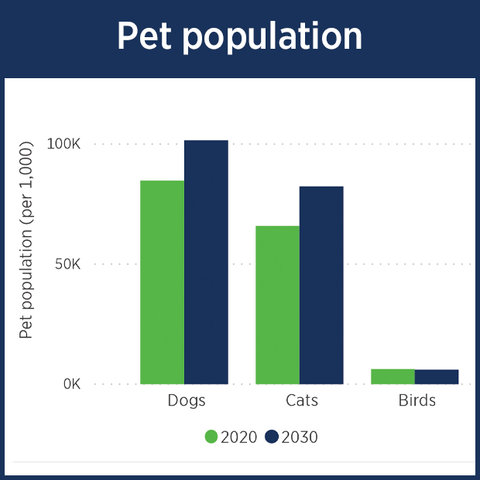Pet populations are on the way up
Over the next 10 years the number of dogs and cats in the U.S. is expected to increase substantially. Today’s Chart of the Month shows that the dog population is projected to grow from 85 million in 2020 to over 100 million by 2030. The cat population is expected to increase even more dramatically, from 65 million to more than 82 million.
This projection is based on a new veterinary workforce model developed by the AVMA in collaboration with a team of economists at Mississippi State University and World Agricultural Economic and Environmental Services. The model explores trends, patterns, and projections likely to take shape in veterinary medicine over the next decade. It can help practitioners understand where the profession is headed and prepare for the future.
Based on the latest economic and industry research, the model offers forecasts in these categories: veterinarian population, species focus, and average salary; livestock and pet populations; demand for veterinarians; pet owner demographics and attitudes; and expenditures and services for dogs and cats.
What the data show
In addition to the growing population of dogs and cats, other key insights include the following:
- The number of active veterinarians in the U.S. is expected to continue increasing through at least 2030, with substantial increases in companion animal practitioners and small increases for food animal, equine, and mixed animal veterinarians.
- Average starting salaries are expected to rise from $88,000 to $102,000 for companion animal veterinarians, and from $80,500 to nearly $94,000 for food animal veterinarians. In the public sector, a net gain of veterinarians will be driven by more people working in higher education, industry/corporate, and nonprofit practice.
- The proportion of households owning a dog is expected to grow from 38% of all U.S. households now to 45% by 2030.
- The share of dogs receiving wellness exams has grown rapidly from 78% in 2011 to 90% in 2016. That number is expected to grow more slowly through 2030, ultimately reaching 96% of dogs. For cats, wellness visits are expected to continue growing through 2030, reaching nearly 80% (up from around 65% in 2016).
- Most Americans consider their pets to be family members, and this trend will continue. For dogs the number is expected to rise from 86% to nearly 96%, and for cats from 80% to 84% by 2030.
Harnessing information to prepare for the future
There are many ways to use this information – from strategic business planning, to identifying untapped opportunities, to implementing new services and enhancing patient care. Looking at the data on pets and pet populations, for example, there are several key takeaways to consider:
- Cat population numbers are growing faster than dogs, suggesting a growing market and demand for veterinary services in feline medicine.
- As pet populations increase, so will wellness exams and demand for other veterinary services, both medical and non-medical like boarding and grooming.
- The large percentage of dogs now receiving wellness exams shows that veterinarians’ efforts to educate pet owners about the value of this care have had a real impact. It also tells us that wellness checks as an area of service represent only limited growth potential over the next decade, because so many dogs already receive them. Veterinarians who see a high proportion of dogs should be exploring other ways to provide value to patients and clients. For cats, on the other hand, wellness exams are still steadily increasing.
This is all crucial information that can help us better understand the changing needs of clients and patients, and identify new ways to continue serving them.
Explore the workforce model
AVMA and Student AVMA members can explore the workforce model in depth through an interactive dashboard available on the AVMA website. View nationwide industry trends and drill down to your specific location, practice type, and areas of interest to find the information most pertinent to you.
Resources to help
Whatever direction the research points you to, AVMA has a wide range of tools and resources to help you take the next steps and stay competitive. They’re available at avma.org/StayCompetitive.





Comments
Add New Comment